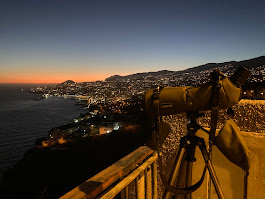Portuguese version:
Olá, chamo-me Rosa e juntei-me recentemente à SPEA Madeira para trabalhar como voluntária. Apesar de estar aqui há apenas um mês, já tive a oportunidade de aprender e fazer muitas coisas novas. Neste blog, darei uma pequena amostra do que fiz até agora.
 |
| Olhando para as aves |
Na SPEA, estamos atualmente a trabalhar num projeto sobre aves marinhas e poluição luminosa. Tenho lido sobre como a poluição luminosa pode afetar as aves marinhas e outros organismos, como insetos e plantas. A luz artificial noturna (ALAN) pode criar problemas para a orientação das aves, padrões de migração e ritmo circadiano. As aves marinhas possuem um sistema de navegação muito avançado e fascinante. Eles podem viajar grandes distâncias no exterior e usar sinais de navegação como as estrelas e a lua para guiá-los. Se houver luzes fortes, as aves podem ficar desorientadas e isso pode resultar em exaustão ou colisões com edifícios. Quando as aves marinhas jovens estão emplumando, elas também podem ser atraídas por luzes brilhantes, como postes de luz e luzes vindas de hotéis. O mesmo se aplica aos filhotes de tartarugas marinhas que encontram o caminho para o oceano e se distraem com a luz artificial. Para mim, o facto de criaturas que evoluíram ao longo de milhares e milhões de anos e que possuem um sentido de ser e sabedoria próprios, é uma grande motivação para trabalhar no problema da poluição luminosa.
Nas últimas semanas, realizámos diversas atividades no terreno e no escritório da SPEA. Fomos a vários locais da Madeira para colocar e recarregar Unidades Autónomas de Gravação (ARUs). Esses dispositivos são utilizados para registrar sons na área e permitem identificar potenciais colônias de aves marinhas. Também fizemos algumas viagens a campo para fazer prospeção de pássaros e ouvir vocalizações de pássaros. Isto deu-me a oportunidade de aprender mais sobre como identificar os diferentes tipos de aves marinhas na vida real. Vimos e ouvimos muito a Cagarra. Eles têm uma vocalização muito interessante e difícil de esquecer, por assim dizer.
Já vi muitas paisagens lindas graças ao trabalho de campo que fizemos. É muito bom podermos ver locais que de outra forma você não iria. Além disso, trabalhar à noite durante o trabalho de campo me tornou mais consciente da poluição luminosa. Às vezes havia luzes muito brilhantes ao redor, o que era um pouco perturbador com as coisas que aprendi sobre seus efeitos na natureza e nos humanos. Nas próximas semanas quero trabalhar mais sobre como de mitigar a poluição luminosa.
 |
| Ouvindo as aves |
English version:
Olá, My name is Rosa and I recently joined SPEA Madeira to work as a volunteer. Although I've only been here for just a month, I already had the opportunity to learn and do a lot of new things. In this blog, I will give a little peak into what I have done so far.
 |
| Looking at birds |
 |
| Listening to birds |
 |
| Example of excessive light |

Sem comentários:
Enviar um comentário